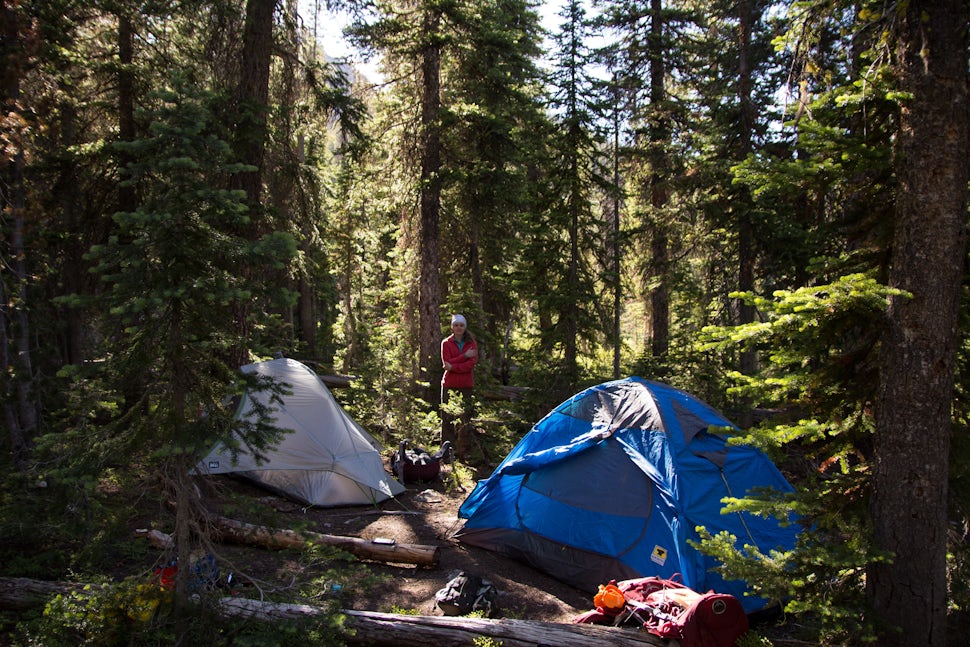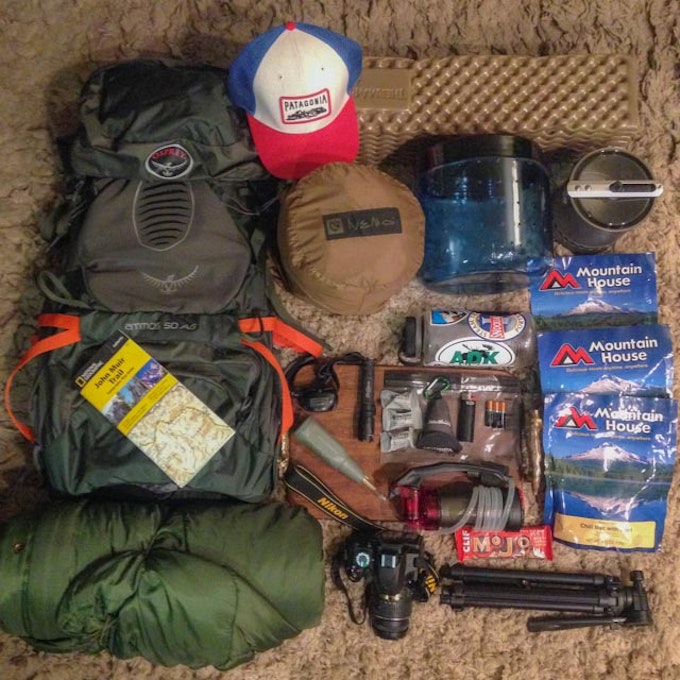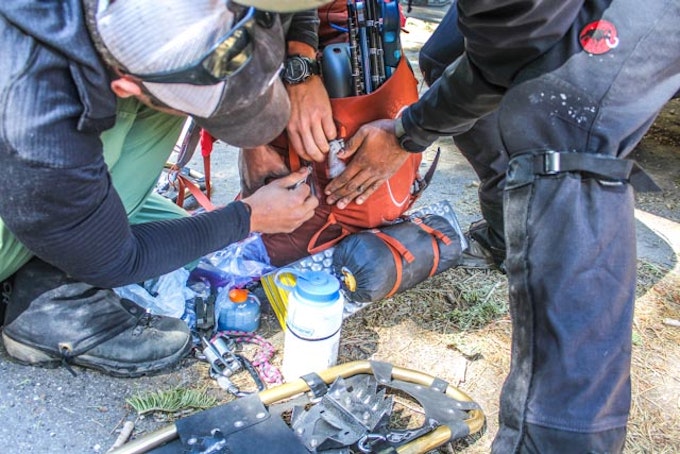5 Tips to Prevent a Disaster During Your First Backpacking Trip
Follow a few basic steps and you will prevent a nice weekend backpacking trip from becoming a disastrous survival situation.

1. Do a Good Map Study
Start your trip weeks or days prior to hitting the trail. You don't have to have the exact grid coordinates for where you will camp, but knowing the general area will make the entire trip easier and more comfortable. Buying large general maps and detailed topographic maps of the area will allow you to determine the large general area and then pinpoint the area in which you will hike and camp. These maps will show you which trails you can use, bodies of water, terrain features, elevation lines, etc. Just looking over the map for 15 -20 minutes will help you tremendously. Not knowing your cardinal directions and general land features can turn a causal relaxing hike into a survival situation. Although many people might considerate it cheating, a GPS is also a great way to prepare for your trip. A GPS can download topographic maps and do most of the work for you, but don't relay on them. Every form of technology will eventually fail. It will probably happen when you need it most.
2. Study Weather Conditions
Ican't emphasize enough how important this step is. Countless times I havewatched the weather change from a sunny day, to dropping 20-30 degrees with a storm rolling in before you have time to prepare. At a minimum,look at the weather forecast for the days in which you are on trail, but don't just rely on that forecast. Weathermen are the only people inthe world who can fail at their job everyday and not get fired, so doyour own secondary research. Determine where the weather reader islocated. Sometimes these weather readers may be 20 miles away from yourcampsite and at a totally different elevation. Elevation and terrainplay a major roll in weather conditions. You may be fine camping in 40degree weather at 10,000 feet nestled in the tree line with zero wind.But just a 1/2 mile away on the other side of the mountain, someone mayhave set up camp at 11,000 feet out of the tree line and directly in the path of 30 mph winds. Temperature decreases 3.3 degrees when itsovercast and 5.4 degrees when its clear for every thousand feet gainedand the windchill will always drop the temperature, that math is toocomplicated (refer to www.nws.noaa.gov). So studying your map, choosing agood campsite, and understanding the weather where you are camping, will make your trip much more comfortable, as well as safer. Also try looking up old archives and averages of weather in the area for the time ofyear you will be visiting. This will help you determine if you need tobring that extra layer of clothing or an extra liter of water. Check out this story to learn some more techniques.
3. Make a Detailed Packing List
Everyone has the intention of packing light, but ends up with everything but the kitchen sink. The fist step in taking as little as possible is to buy a smaller pack than you think you may need. If you read a guide book that says you need a 60 liter pack, buy or bring a 50 liter pack. Second, make a list of all the camping, survival, and modern amenities you want to bring on the trip. Third, go down that entire list two or three times and try to remove 2 items each time. Depending
on the trip, you can leave home without any item on your list. You may think it is impossible to leave home without water, food or shelter right? Well if you plan accordingly you can leave it all behind. Now I'm not saying to run out into the wild with the clothes on your back and a knife in your teeth, but I am trying to save you from carrying unnecessary pounds. Items like water, food, and shelter may already be on the trail if you use a little ingenuity. Collect fresh water from
lakes or creeks and catch fish to eat every night for dinner!
4. Determine Pack Layout
The perfect pack layout can only be determined by you and you alone. Once you have narrowed down the exact items for your trip, start mixing and matching where they fit best. Don't act like zombies are coming and cram every item into your pack randomly. I have never packed my bag right on the first try. Try multiple different places for different items and try it on your back after each pack. Also do a little study of where your items are and how you can find those items in the dark. Can you find your extra batteries in the dark when your headlamp goes out? No? Well, you will end up setting up your tent in the dark. Plan for the worst, know your gear, and your backpacking trip will be that much more enjoyable. Of course there is the tried and tested way to pack, but each person has a different pack, different physical fitness level, skill level and body type. What works for the best hiker in the world may not work for you. So get out and test your pack loaded up before a long hike. I usually follow the old basic routine of light items at the bottom (sleeping bag), heavy items in the middle (tent, water) and medium to light weight items at the top (camp stove, ground pad). Use these tips and make some of your own.
5. Test and Maintain Equipment
Multiple times on trail I've come across someone or been the one with a broken backpack strap, an empty canister of cooking fuel, or a broken tent pole. Sometimes these events can't be avoided and sometimes it adds to the fun/challenge of the adventure. But most of the time this is due to poor planning, and not testing your equipment. Make sure you bring some items like duct tape, paracord, or safety pins. On my last backpacking trip, a zipper broke and my three safety pins held my bag together for three days. Every essential item, such as your camelbak, cooking stove, tent poles and backpack straps must be checked prior to any hike. Checking your camelbak for leaks, making sure your stove works and you have adequate fuel for the duration of the trip, checking tent poles for cracks/bends, and checking backpack straps for wear and tear can do wonders. Not only is checking and testing your gear important, but maintaining it may be the most important. Every time after that long weekend in the wild, I just want to throw my pack down and crash on the couch. But being lazy now, and not taking 30 minutes to air out and clean your gear could spell disaster for your next trip. Items hold in moisture and dirt which can turn into mildew and ruin your gear, costing you money, time and comfort. Rinse out items like your camelbak and cooking equipment,and dry out your tent and sleeping bag. You will be thankful at the start of your next trip.
Extra Tip: Bring Small Comforts From Home
Each time you step out into the unknown it should be a life changing, learning, and memorable experience you enjoy. If you aren't having fun then you need to change some things up. You don't have to live off the land or go without a shower for weeks to feel like you are one with nature. Small amenities from home can mean all the difference. Items I always pack are small containers with different spices, lemon for flavor on fresh caught fish, and a small cup of pre-made buttered rice or vegetables can make a huge difference when mixed with your hot dog dinner. And if you have a vice, don't choose this hike to quit or you will never want to go back. If you are a smoker, addicted to chocolate or sour patch kids like myself, make sure you bring them along. Smokers just pack out your butts, no one behind you wants to see that in nature and the risk of starting a fire is also a reason to be cautious. Get creative and mix sweets into your trail mix. Bring some flavored Gatorade or tea packets to mix with the clear fresh mountain water. Whatever your heart desires, bring it with you to make an enjoyable hike into the wild that much more enjoyable.
Cover photo: Garren Moore
We want to acknowledge and thank the past, present, and future generations of all Native Nations and Indigenous Peoples whose ancestral lands we travel, explore, and play on. Always practice Leave No Trace ethics on your adventures and follow local regulations. Please explore responsibly!
Do you love the outdoors?
Yep, us too. That's why we send you the best local adventures, stories, and expert advice, right to your inbox.










